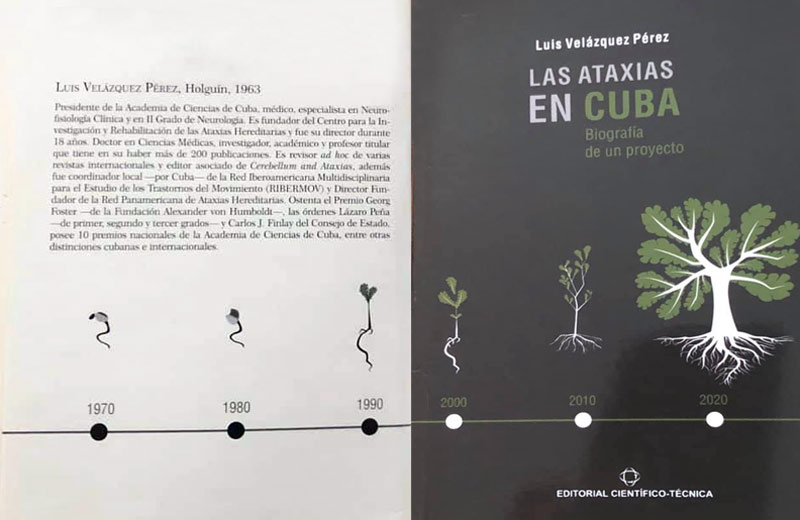Holguin: Book on the 20th anniversary of the Ataxias Center to be launched
- Written by Lourdes Pichs Rodríguez
- Published in Holguin
- Hits: 1246

The book Ataxias hereditarias en Cuba, biografía de un proyecto, by DrCs Luis Velazquez Perez founder and former director of the Center for Research and Rehabilitation of Hereditary Ataxias (Cirah), will be launched in Holguin on the occasion of the 20th anniversary of this health institution.
“Its prologue was written by a special person from Holguin, who suffers from the disease. It is a song to the sacrifice of many people, but that opens the doors to a better future, ”he explained.
The doctor, who has more than 200 scientific publications, wrote in his Facebook account, that “the history of an institution, located almost 800 km from the capital, shows how a group of young but committed scientists decided to dedicate ourselves and challenge this disease. The greatest achievements are not just the trained doctors or the already 300 articles written on the subject. The greatest achievements are in the impact on the Cuban families and other regions of the world, in terms of medical assistance, rehabilitation, genetic counseling; the predictive programs developed and the humanisms of this team.
“The Cirah began its work in March 2000 with the aim of combining medical assistance with scientific research and the results that came out of the research had a direct impact on Cuban families with this disease, which resulted in Translational Medicine that is not apply it in all countries, but Cuba has the possibility of doing so in this regard, ”he said.
Cuba is the country with the highest concentration of patients with Hereditary Ataxias, with a prevalence of 8.91 cases per 100 thousand inhabitants, but Spinocerebelose Type 2 (SCA2) is the most frequent molecular form found in Cuba, and Holguin is the province with the largest number of patients concentrated.
A national epidemiological study conducted in 2017 and 2018 showed the existence of 848 cases (87.42 percent), belonging to 124 families diagnosed with SCA2; as well as 9,791 descendants at risk, which indicates that this disease constitutes a serious health problem for our country.
That is a disease of a family nature; it is inherited in an autosomal dominant way, so each descendant of a patient has a 50 percent chance of inheriting the SCA2 gene.
"Now it is time to move towards the cure of this disabling degenerative condition, but this requires being more prepared to get into this new stage properly."
Velazquez was promoted two years ago to President of the Academy of Sciences of Cuba (ACC).
Velazquez explained that the book collects the story told by one of its protagonists. It reflects the efforts carried out in the last years in the search for therapeutic targets and become a kind of model to be used and applied by any project or research in Cuba or other country.
“Its prologue was written by a special person from Holguin, who suffers from the disease. It is a song to the sacrifice of many people, but that opens the doors to a better future, ”he explained.
The doctor, who has more than 200 scientific publications, wrote in his Facebook account, that “the history of an institution, located almost 800 km from the capital, shows how a group of young but committed scientists decided to dedicate ourselves and challenge this disease. The greatest achievements are not just the trained doctors or the already 300 articles written on the subject. The greatest achievements are in the impact on the Cuban families and other regions of the world, in terms of medical assistance, rehabilitation, genetic counseling; the predictive programs developed and the humanisms of this team.
Congratulations to all, as this project has made us more humane.”
“The Cirah began its work in March 2000 with the aim of combining medical assistance with scientific research and the results that came out of the research had a direct impact on Cuban families with this disease, which resulted in Translational Medicine that is not apply it in all countries, but Cuba has the possibility of doing so in this regard, ”he said.
Cuba is the country with the highest concentration of patients with Hereditary Ataxias, with a prevalence of 8.91 cases per 100 thousand inhabitants, but Spinocerebelose Type 2 (SCA2) is the most frequent molecular form found in Cuba, and Holguin is the province with the largest number of patients concentrated.
A national epidemiological study conducted in 2017 and 2018 showed the existence of 848 cases (87.42 percent), belonging to 124 families diagnosed with SCA2; as well as 9,791 descendants at risk, which indicates that this disease constitutes a serious health problem for our country.
That is a disease of a family nature; it is inherited in an autosomal dominant way, so each descendant of a patient has a 50 percent chance of inheriting the SCA2 gene.
“Today we know that we can change the course of the disease, delay its onset, which seemed like a utopia. That is today the main merit of the Center for Research and Rehabilitation of Hereditary Ataxias (Cirah), achieved as a result of the eight clinical trials carried out, in addition to research in the area of rehabilitation, which has allowed us to count on a treatment protocol,” Dr. Luis Velazquez added.
"Now it is time to move towards the cure of this disabling degenerative condition, but this requires being more prepared to get into this new stage properly."
Velazquez was promoted two years ago to President of the Academy of Sciences of Cuba (ACC).
